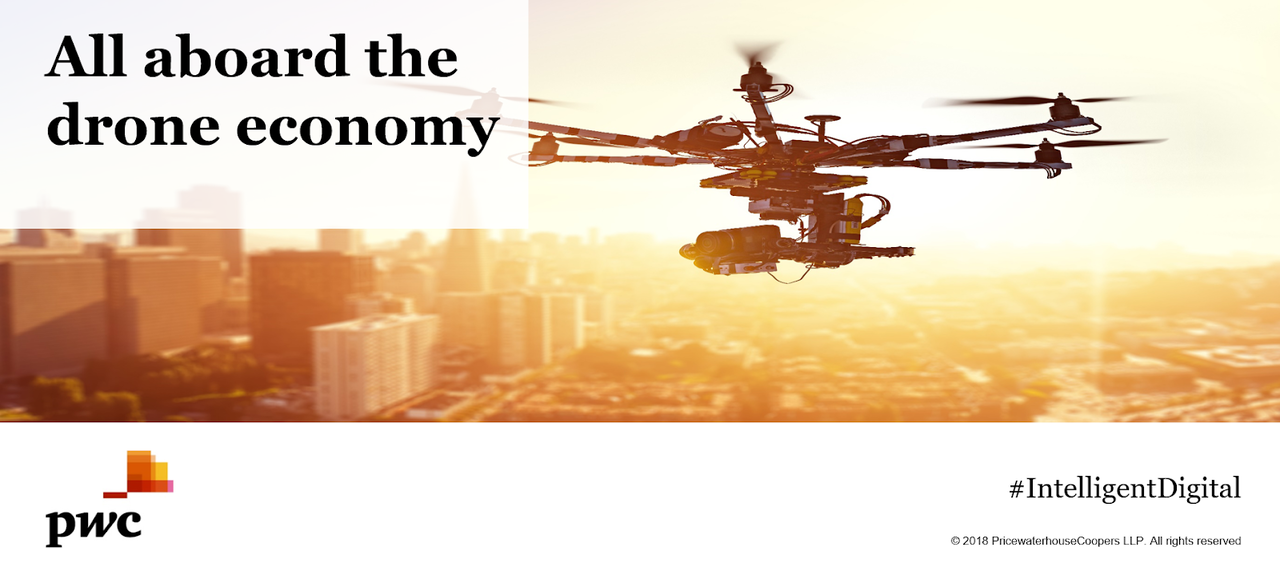
All aboard the drone economy
New technologies that promise to improve business efficiency can sometimes be greeted with caution by people in the workplace. The underlying concern being that the technology in question will reduce the requirement for human capital and jobs will disappear. However, what often happens with the arrival of a new technology is the opposite – an economy develops a completely new set of roles and functions, and increased productivity drives growth and more, not fewer, jobs.
When we look at the emerging drone economy, the situation is no different.
In our recently published “Skies without Limits” report we estimated that drone technology would be responsible for a £42 billion uplift to GDP in the UK by 2030, and that uplift would result in the creation of 628,000 jobs that rely on drones. We also estimated that 76,000 drones would be in UK airspace in the same timeframe, many of which will be autonomous. The implications of this last figure are clear – the majority of new jobs being created will be related to the entire drone value chain, rather than being limited to new commercial drone pilots.
At the time of writing, the UK’s Civil Aviation Authority (CAA) lists 4411 active CAA-approved commercial operators of Small Unmanned Aircraft. We expect the number of licenced drone operators to far exceed the number of drones flying at any one time, meaning it to is likely to become commoditised. Mass automation could also see multiple drones being operated by one remote pilot.
However, there will be need for new types of workers to think creatively about how drones can be developed and applied, and to build, maintain, and regulate the devices and related technologies. Businesses that engage with drone technology will open up a range of exciting opportunities to upskill their existing staff.
The types of jobs that will be created in the drone economy will differ from industry to industry.
In the survey and inspection field, expected advances in payloads and Beyond Visual Line of Sight (BVLOS) flying is likely to result in drones replacing more expensive helicopters in many applications. Combined with the use of sophisticated algorithms that use point cloud data from laser scanning to precisely calculate critical '3D' parameters, such as vegetation encroachment and conductor sag height on powerlines, the impact of technology convergence will be significant.
By 2030, accident response drones may well be a common sight above the UK's roads. They will enable live data from accident scenes to be shared in real time with the emergency services, meaning they know what to expect and can arrive fully prepared.
Drones will also be able to record and store the evidence from an accident quickly and without intrusion, reducing the amount of time it takes to reopen the road. Multiple autonomous drones may be sent to an accident site to work in concert. In addition to a drone providing live-streamed video, there may be a drone acting as a 5G cell tower to ensure effective communication between the emergency services.
The types of drones being used will differ according to each use case, and expertise will be needed in the design of drone hardware and software for use in each scenario. Analysts who bring the crucial element of business acumen will be called upon to extract intelligence from data collected and inform decisions that benefit customers and the business.
Talent requirements in the drone economy will evolve.
In professional services we’re likely to see the emergence of drone lawyers who specialise in the intricacies of the regulation that will be required to ensure drones operate safely and that information gathered by drones is done so within the law. Organisations looking to adopt drone technology will also come to rely on specialist consultants who can balance business understanding with technology innovation and human insight and help provide intelligent digital solutions.
There will be a greater need for data scientists and robotics engineers, and there will be an increase in the value of human skills that can’t be replicated by machines, such as creativity, leadership, problem-solving and emotional intelligence.
When it comes to creative uses of drone technology, the sky is no longer the limit. Ten years ago the role of the app developer had only just emerged and we were standing at the frontier of a new digital landscape. Over the course of the next decade we will see entirely new businesses emerge built on drone technology that disrupt existing models and take the UK’s economy to new heights.
Available for work at Available
5yAn emerging sector for sure!
Bazaar Consulting
5yMahmut Coban
Organisational Transformation | Leadership | Strategy & Business Development
5yGreat article x
Organisational Transformation | Leadership | Strategy & Business Development
5yStewart Miller Mike Buckley
Director, Fixed wing and Helicopter pilot | Professional photographer | Video Producer - specialising in producing high quality stunning photography and video
5ySéamus Hugh Kearns - Have you seen this? Great Article